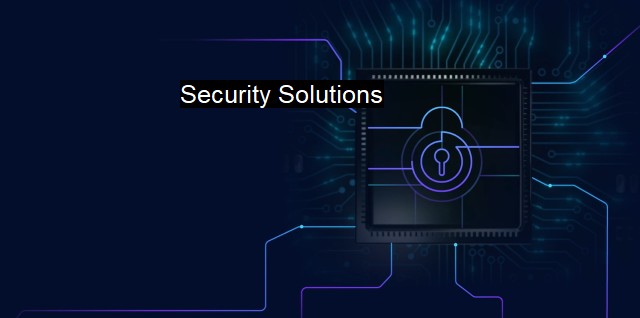What are Security Solutions?
Implementing Comprehensive Security Solutions to Prevent Cyber Threats and Virus Attacks
Security solutions refer to the collective measures, tools, and strategies used to protect digital information, databases, networks, and systems from attacks, damages, or illegal access in the realm of information technology. Predominantly encompassing cybersecurity and antivirus software, these security solutions are designed to minimize security vulnerabilities that can lead to a breach of data, loss of critical business information, or compromise of digital privacy.A study in cybersecurity typically begins with an understanding of the potential threats which exist. The threats range from hackers looking to steal sensitive data, to advanced persistent threats which target particular organizations, to destructive malware which can paralyze an entire network. It is also important to acknowledge internally sourced threats which may come from a disgruntled or negligent employee.
The confronting threat-forms necessitate a vast array of security solutions. At one end of the spectrum, we have antivirus software, one of the most commonly used and known security solution tools. Antivirus software is designed to prevent, search for, detect, and remove software viruses, along with other malicious software like worms, trojans, adware, and more. It provides the initial line of defense against unauthorized software from executing on a computer, network, or system.
There's also firewall security, which serves as a protective barrier separating a trusted network (e.g., an individual’s or a company’s private network) from an untrusted one (e.g., the Internet). Firewalls control and manage network traffic based on certain security rules and help block unauthorized access to or from the private network.
Encryption, a method of scrambling data into an unreadable format known as ciphertext, is another crucial security solution tool. It ensures that even if a hacker gains unauthorized access to an organization's valuable data, they still wouldn't be able to interpret or misuse the encrypted data. To read an encrypted file, one must have access to a secret key or password that enables the decryption process.
Next up in the arsenal of solutions is Intrusion Detection Systems (IDS) and Intrusion Prevention Systems (IPS). These tools monitor network traffic and flag any suspicious activity, which might indicate a cybersecurity threat. While IDS simply detect and alert to the possible intrusion, IPS go a step further and take actions like blocking access to the suspicious IP address.
Moving on to more advanced solutions, Security Information and Event Management (SIEM) and Next-Generation Firewalls (NGFW) have become essential parts of an organization's security infrastructure. SIEM software provides real-time analysis of security alerts generated by applications and network hardware. NGFWs, on the other hand, extend the functionalities of a traditional firewall and incorporate other network device filtering functionalities too, such as an intrusion prevention system.
Artificial intelligence (AI) and machine learning (ML) are playing an increasingly central role in cybersecurity solutions. They help automate the cybersecurity process by analyzing a vast amount of data in real-time, identifying patterns and anomalies faster, and accurately predicting security events before they may occur.
Emerging trends and advancements like endpoint security, security orchestration automation and response (SOAR), and cloud access security broker (CASB) also form part of the modern security solutions landscape. These techniques work to add protection in areas where traditional security systems do not cover, like cloud data protection and maintaining security in an automated, yet coordinated manner.
In a digital world where emerging technologies make every aspect of our lives better, it's substantial to note that they do pose some potential risks and vulnerabilities. Amid this incredibly rapid digital transition, security solutions play a vital part in making the digital era safer and more reliable. These cybersecurity and antivirus measures serve as the bulwark between the relative safety of internal systems and networks, and potential breaches and invasions that could result in destructive losses.

Security Solutions FAQs
What is a security solution?
A security solution is a set of software and hardware tools designed to protect computer systems and data from unauthorized access, theft, and other cyber threats. It typically includes antivirus, firewalls, intrusion detection and prevention systems, and other security technologies.What is antivirus software?
Antivirus software is a type of security solution that is designed to prevent, detect, and remove malware such as viruses, worms, and Trojan horses from computer systems. It works by scanning files and programs for known patterns of malicious code and blocking or quarantining any suspicious activity.What is a firewall?
A firewall is a network security tool that monitors and controls incoming and outgoing network traffic based on predetermined security rules. It can prevent unauthorized access to a system, block malicious traffic, and protect sensitive data from theft or damage.How do security solutions improve cybersecurity?
Security solutions improve cybersecurity by providing multiple layers of protection against various types of cyber threats. They can detect and block malware, prevent unauthorized access, monitor network traffic, and analyze system activity to detect and respond to security incidents. By implementing a comprehensive security solution, organizations can reduce the risk of data breaches, minimize the impact of cyber attacks, and protect their reputation and business operations.| | A | | | B | | | C | | | D | | | E | | | F | | | G | | | H | | | I | | | J | | | K | | | L | | | M | |
| | N | | | O | | | P | | | Q | | | R | | | S | | | T | | | U | | | V | | | W | | | X | | | Y | | | Z | |
| | 1 | | | 2 | | | 3 | | | 4 | | | 7 | | | 8 | | |||||||